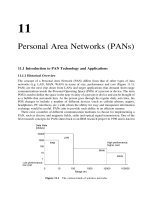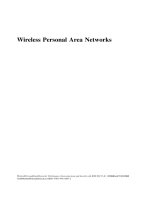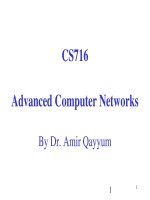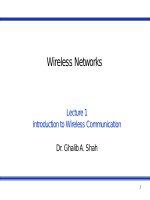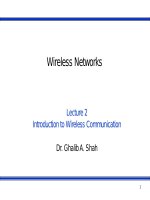Wireless networks - Lecture 39: Bluetooth/Wireless personal area networks (WPAN)
Bạn đang xem bản rút gọn của tài liệu. Xem và tải ngay bản đầy đủ của tài liệu tại đây (618.83 KB, 34 trang )
Wireless Networks
Lecture 39
Bluetooth/Wireless Personal Area Networks (WPAN)
Dr. Ghalib A. Shah
1
Outlines
Bluetooth introduction
Technical features
Access technique
Bluetooth topology/scenario
Specifications
Architecture
Core Protocols
Packet format
Link connections
2
Last Lecture
Security primitives in TinySec
Encryption Schemes
Keying mechanism
WMSN
►
►
►
►
►
Architecture
Applications
Advantages
Design Considerations
Protocols
WSAN
►
►
►
►
Motivation
WSN vs WSAN
Architecture
Issues
3
What is Bluetooth?
“Bluetooth wireless technology is
►
►
►
►
an open specification for a
low-cost, low-power, short-range radio technology
for ad-hoc wireless communication of
voice and data anywhere in the world.”
4
Ultimate Headset
5
Cordless Computer
6
Bluetooth Application Areas
Data and voice access points
► Real-time voice and data transmissions
Cable replacement
► Eliminates need for numerous cable attachments for
connection
Ad hoc networking
► Device with Bluetooth radio can establish connection
with another when in range
7
Overview of Bluetooth History
What is Bluetooth?
► Bluetooth is a short-range wireless communications
technology.
Why this name?
► It was taken from the 10th century Danish King Harald
Blatand who unified Denmark and Norway.
When does it appear?
► 1994 – Ericsson study on a wireless technology to link
mobile phones & accessories.
► 5 companies joined to form the Bluetooth Special
Interest Group (SIG) in 1998.
► First specification released in J uly 1999.
8
Technical features
Conne ction Type
Spread Spectrum (Frequency Hopping)
& Time Division Duplex (1600
hops/sec)
S pe ctrum
2.4 GHz ISM Open Band (79 MHz of
spectrum =79 channels)
Modulation
Gaussian Frequency Shift Keying
Trans m is s ion Powe r
1 mw – 100 mw
Data R ate
1 Mbps
R ange
30 ft
S upporte d S tations
8 devices
Data S e curity –Authe ntication
Ke y
128 bit key
Data S e curity –Encryption Ke y
8-128 bits (configurable)
Module s iz e
9 x 9 mm
9
Time-Division Duplex Scheme
Channel is divided into consecutive slots (each 625 s)
One packet can be transmitted per slot
Subsequent slots are alternatively used for transmitting and
receiving
► Strict alternation of slots between the master and the slaves
► Master can send packets to a slave only in EVEN slots
► Slave can send packets to the master only in the ODD slots
10
Radio Specification
Classes of transmitters
► Class 1: Outputs 100 mW for maximum range
• Power control mandatory
• Provides greatest distance
► Class 2: Outputs 2.4 mW at maximum
• Power control optional
► Class 3: Nominal output is 1 mW
• Lowest power
11
Typical Bluetooth Scenario
Bluetooth will support wireless point-to-point
and point-to-multipoint (broadcast) between
devices in a piconet.
Point to Point Link
m
► Master - slave relationship
► Bluetooth devices can function as masters or slaves
s
Piconet
► It is the network formed by a Master and one or more
slaves (max 7)
► Each piconet is defined by a different hopping
channel to which users synchronize to
► Each piconet has max capacity (1 Mbps)
s
12
m
s
s
Piconet Structure
Master
Active Slave
Parked Slave
Standby
All devices in piconet hop together.
Master’s ID and master’s clock determines frequency hopping
sequence & phase.
Hopping sequence shared with all devices on piconet
Bluetooth devices use time division duplex (TDD)
Access technique is TDMA
FH-TDD-TDMA
13
Ad-hoc Network – the Scatternet
Inter-piconet
communication
Up to 10 piconets in a
scatternet
Multiple piconets can
operate within same
physical space
This is an ad-hoc, peer to
peer (P2P) network
14
Bluetooth Standards Documents
Core specifications
► Details of various layers of Bluetooth protocol
architecture
► Bluetooth is a layered protocol architecture
•
•
•
Core protocols
Cable replacement and telephony control protocols
Adopted protocols
Profile specifications
► Use of Bluetooth technology to support various
applications
15
Profiles
Generic Access Profile
Service Discovery Application Profile
Cordless Telephony Profile
Intercom Profile
Serial Port Profile
Headset Profile
Dial-up Networking Profile
Fax Profile
LAN Access Profile
Generic Object Exchange Profile
Object Push Profile
File Transfer Profile
Synchronization Profile
16
Architecture
Core protocols
Radio
Baseband
Link manager protocol
(LMP)
Logical link control and
adaptation protocol
(L2CAP)
Service discovery
protocol (SDP)
ble replacement protocol
RFCOMM
lephony control protocol
Telephony control specification – binary (TCS BIN)
opted protocols
PPP
TCP/UDP/IP
OBEX
WAE/WAP
17
Core Protocols
Radio:
►
►
Baseband:
►
It is transactional protocol between two link management entities used to setup
properties of BT link. For example a device may authenticate each other, may
learn each others features (SCO/ACL links, size of packet, power consumption
mode).
Host Constroller Interface (HCI):
►
Defines procedure to communicate with other BT devices like formation of
piconets, links in a piconet (ACL or SCO), and access of transmit resources in
a piconet etc.
Link Manager protocol (LMP):
►
defines technical characteristics of BT radios.
For example licence-free ISM band 2.4 GHz, FHSS at 1600 Hops/sec, 1 MHz
channel bandwidth, GMSK modulation, tx power from 100 mw to 1 mw, raw
transmission rate of 1 Mbps and so on.
it is not a protocol rather an interface through which BT devices access the
lower layers of BT protocol stack. A device may pass and receive data
destined to or coming from another BT device, execute inquiries, request
authentication and so on.
Logical Link Control and Adaptation protocol (L2CAP):
►
shields the specifics of BT lower layers and provides a packet interface to
higher layers.
18
Bluetooth protocols
Service Discovery Protocol (SDP)
► Defines a service record format
• Information about services provided by attribute s
• Attributes composed of an ID (name) and a value
• IDs may be universally unique identifiers (UUIDs)
► Defines an inquiry/response protocol for discovering
services
• Searching for and browsing services
19
Bluetooth protocols
RFCOMM (based on GSM TS07.10)
► emulates a serial-port to support a large base of legacy (serialport-based) applications
► allows multiple “ports” over a single physical channel between
two devices
Telephony Control Protocol Spec (TCS)
► call control (setup & release)
► group management for gateway serving multiple devices
Legacy protocol reuse
► reuse existing protocols, e.g., IrDA’s OBEX, or WAP for
interacting with applications on phones
20
Baseband
Addressing
► Blue to o th de vic e addre s s (BD_ADDR)
– 48 bit IEEE MAC address
► Ac tive Me mbe r addre s s (AM_ADDR)
– 3 bits active slave address
– all zero broadcast address
► Parke d Me mbe r addre s s (PM_ADDR)
– 8 bit parked slave address
This MAC address is split into three parts
► The No ns ig nific ant Addre s s Part (NAP)
– Used for encryption seed
► The Uppe r Addre s s part (UAP)
– Used for error correction seed initialization & FH sequence generation
► The Lo we r Addre s s Part (LAP)
– Used for FH sequence generation
21
Packet Structure
72 bits
Access
Code
54 bits
Header
Voice
No CRC
FEC (optional)
0 - 2744 bits
Payload
header
Data
CRC
ARQ
FEC (optional)
22
Types of Access Codes
Channel access code (CAC) – identifies a piconet
Device access code (DAC) – used for paging and
subsequent responses
Inquiry access code (IAC) – used for inquiry
purposes
23
Inquiry Procedure
Potential master identifies devices in range that wish to
participate
► Transmits ID packet with inquiry access code (IAC)
► Occurs in Inquiry state
Device receives inquiry
► Enter Inquiry Response state
► Returns FHS packet with address and timing information
► Moves to page scan state
24
Page Procedure
Master uses devices address to calculate a page
frequencyhopping sequence
Master pages with ID packet and device access code
(DAC) of specific slave
Slave responds with DAC ID packet
Master responds with its FHS packet
Slave confirms receipt with DAC ID
Slaves moves to Connection state
25


